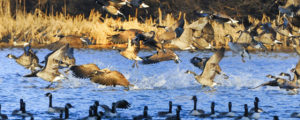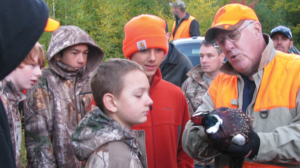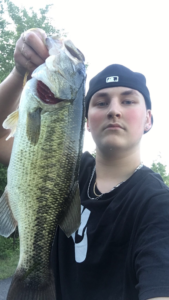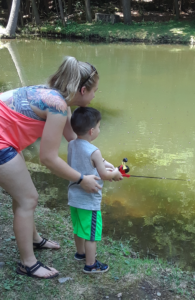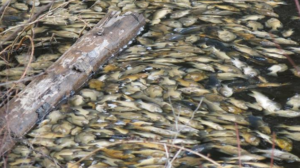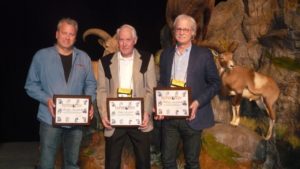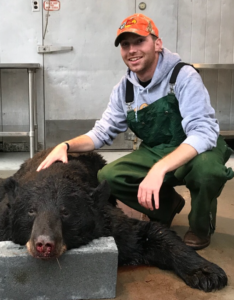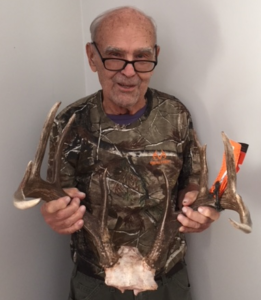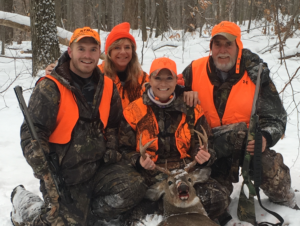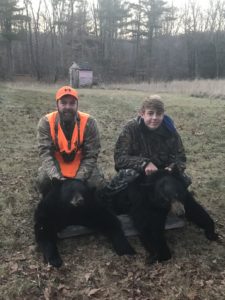Last weekend I bumped into old buddy Ken Kirchener on Ashmere Lake in Hinsdale When he saw me, he shouted over the boat engine noise, “I have a story for you”. He had witnessed an interesting event and wondered if readers would find it interesting, too.
On September 1 around 11:30 am, Ken was driving along the Skyline Trail in Hinsdale and on a manicured lawn, he spotted a doe walking along a hedge row. Right out of nowhere there appeared a spike-horn buck behind it. The doe crossed the road but the buck was leery, stopped and looked at Ken. The doe went back across the road to where the buck was standing. Then the doe crossed the road again and this time the buck followed her and stood in the middle of the road. Suddenly behind him there appeared another larger deer. That one was a 4-pt buck.
Then the spike-horned buck turned and the two bucks began fighting thrashing their hooves at one another while standing on their hind legs, right on the blacktop in the middle of the road. “It was just like a boxing match” said Ken. The doe was just standing there on the sideline watching.
The doe then moved into the brush and right behind her went the spike. The 4-pointer followed behind the spike. When a car approached Ken had to move, but when he was able to see the deer again, all three of them were just off the side of the road in some big tall golden rods. Both buck’s antlers were still in velvet.
I asked Ken who won the boxing match but Ken couldn’t tell. He doesn’t usually referee buck fights but he assumes that the spike won because he was the one immediately behind the doe when they went into the woods.
Could this be classified as road rage? Wouldn’t you think those bucks would settle such matters out behind the barn? And the audacity of that doe, is there no modesty left?
Seriously folks Massachusetts deer usually breed between late October and early December. Apparently, these deer were jumping the gun a little bit. During the rutting season, bucks are more active throughout the day than usual and they often chase does across roads without hesitation. MassWildlife urges drivers to be extra cautious and slow down during the fall.
Massachusetts Junior Conservation Camp
On August 17, the traditional outdoor-graduation ceremony of the Massachusetts Junior Conservation Camp (MJCC) in Russell, MA took place.
Since 1949, the MJCC has provided young people with a unique experience of conservation, shooting sports and outdoor recreation education. The 12-day program introduces girls and boys ages 13 to 17-years old to the ethical responsibilities of hunting and fishing in order to foster careful stewardship of natural resources, connections with natural resource professionals and opportunities to learn or enhance their outdoor skills.
During the Graduation Ceremony, awards for the Camp Competition Day were presented and congratulations were offered by Stephen Johnson, MJCC Board President, Ron Amidon, Department of Fish & Game Commissioner and Division of Fisheries and Wildlife (MassWildlife) Director Mark Tisa.
John Gaj of Blandford, MA took first place in archery. Assistant Instructor Jordan Peck of Peru was acknowledged for catching his first fish. Super campers were identified by camp staff for their outstanding leadership skills and compassion. One of the 2019 Super Campers was Kaela Martin of Sheffield.
“We greatly appreciate the support of our camp partners,” said Stephen Johnson, “We are especially grateful for the long-term commitment to Conservation Camp by MassWildlife, the Department of Conservation and Recreation (DCR), the Environmental Police and the Gun Owners Action League. He thanked Dick’s Sporting Goods, Cabela’s, and other sporting goods stores for donations of outdoor equipment for camper use. He also noted that 85% of campers’ tuitions were funded by generous individuals, local and regional sporting clubs and civic organizations. MassWildlife Director Mark Tisa, a past MJCC camper, told campers that his experience at camp years ago inspired him to pursue a career in fisheries.
Campers learn how to safely use firearms, archery, fishing, navigation and camping gear. State Hunter Education courses from MassWildlife and a Safe Boating course are taught by the Environmental Police. Shooting certification in several courses is also offered. Fish and wildlife biologists from MassWildlife and forestry professionals from DCR provide instruction in wildlife, forestry, and fisheries management. Fishing, hiking, outdoor cooking, navigating with GPS and compass, and survival skills learning are provided by experienced outdoor instructors.
Learn more by visiting www.juniorconservationcamp.org or the Camp Facebook page at https://www.facebook.com/Mass-Junior-Conservation-Camp-. The MJCC email is: MAJuniorCamp@gmail.com. The MJCC Board welcomes support for the Conservation Camp through tax-deductible donations.
Parsons Marsh
The Berkshire Natural Resources Council invites you to celebrate the opening of the new accessible trail at Parsons Marsh in Lenox next Saturday, September 15 from 9 am to noon. The event schedule is as follows: 9:00 am Bird Walk with well-known Berkshire birder Ed Neumuth, 10:00 am Music, Kid’s Crafts, 10:30am Ribbon Cutting 10:45 am Music, Cider Pressing, Kid’s Crafts, Explore the new trail. 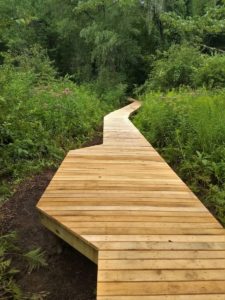
Parking is available at the Stonover Farm’s Event Parking Area, across from 169 Undermountain Rd, Lenox, MA 01240. Carpooling and walking are encouraged.
This is a cooperative trail project between Berkshire Natural Resources Council, the Town of Lenox through its Community Preservation Fund, and the Massachusetts Recreational Trails Program and was also supported by the Lenox Land Trust.
The MassWildlife Habitat Management Grant Program
This program provides financial assistance to private and municipal landowners of conserved lands to improve and manage habitat for game species and other Species of Greatest Conservation Need as identified in the State Wildlife Action Plan. The grant program also aims to expand opportunities for hunting, fishing, and other outdoor recreation, and complement ongoing habitat management work on state lands.
This year EEOEA Secretary Matthew Beaton provided MassWildlife with $300,000 to fund another year of this popular and effective program. Details on how to apply for the MassWildlife Habitat Management Grant can be found at mass.gov/dfw/habitat-grant. The application period is now open with a proposal deadline of October 17, 2018.
Last year, a team of reviewers selected 20 proposals submitted by municipalities, private citizens, and NGOs for projects in 19 towns and cities. The projects included invasive plant control, old field habitat improvement, prescribed fire to enhance habitats, stream restoration work, etc. Approximately 950 acres were successfully managed as a result of the funding.
There are some significant changes to the program this year, including an expansion of eligible lands, and the use of a fillable form for an application. This form application should make it easier for individuals and organizations that are not experienced in grant writing to be able to apply for this funding opportunity to conduct work on land they own or manage.
Turkey Shoots
The Lenox Sportsmen’s Club recently announced that it will be starting its fall turkey shoots on September 16 at 1:00 pm and will run every Sunday until November 18. Shooters are encouraged to bring their shotgun and 22 rifle or pistol to take a shot at winning Thanksgiving Dinner. For more info contact Lorenzo Marangoni: 413-822-7412.
Life Preservers
Don’t forget! From September 15 to May 15 Massachusetts regulations require that anyone using a canoe or kayak must wear a life preserver. Don’t sit on it, wear it!

